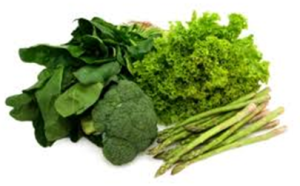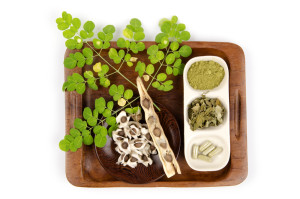
Can you ever recall your doctor prescribing amino acid supplements for some severe food allergies or for gastrointestinal disorders like short bowel syndrome, or malabsorption? You might have wondered why you were taking amino acid supplements for these illnesses! So, in this post, I would like to share some facts about amino acids, its usage and introduce the superfood moringa which happens to be a natural storehouse of amino acids.
Amino acids are at the basis of all life processes as they are important for maintaining the normal metabolic functions of the body. After consuming proteins, like a steak, the proteins break down to amino acids and are absorbed in the bloodstream. These amino acids are further used by different cells of the body to support health and metabolism wherever needed. They are also used in protein synthesis for your body to build and maintain your organs and muscles. Therefore, amino acids are very important and considered as the ‘basic chemical building blocks’ of the body.
metabolism wherever needed. They are also used in protein synthesis for your body to build and maintain your organs and muscles. Therefore, amino acids are very important and considered as the ‘basic chemical building blocks’ of the body.
There are some amino acids that can not be made by our bodies and are only found in the foods we eat. They are known as the essential amino acids.
Some of these essential amino acids are:
- Lysine, which play a role in the growth and bone health;
- Isoleucine, leucine, and valine, which help to maintain muscle protein;
- Methionine, which involve in protein and nucleic acid synthesis;
- Phenylalanine, histidine, threonine and tryptophan, which act as a precursor to serotonin ( the hormone that promotes a positive mood).
Diets with poor quality nutrients will provide a poor supply of amino acids, creating a need for extra supplementation to maintain the body’s essential functions. The superfood Moringa is found to be protein rich and contains all essential amino acids. This plant is considered to be more nutritious than all other greens including spinach and kale. 
Moringa Oleifera is a storehouse of important nutrients and is used both for its nutritional and therapeutic properties. Apart from storing high levels of vitamins and minerals, it also carries all the amino acids needed for the growth and maintenance of a healthy body. To quote Dr. Lowell Fuglie[ii], a West Africa representative of the Church World Service who used Moringa as a foundation for a nutrition program, “for a child aged 1-3, a 100g serving of fresh(ly) cooked leaves would provide all his daily requirements of calcium, about 75% of his iron and half his protein needs, as well as important amounts of potassium, B vitamins, copper and all the essential amino acids.”
In 2007, the World Health Organization (WHO) also documented the fact that the amino acid contents of moringa leaf are higher than required amounts for healthy child’s growth.
In a recently published book, “Miracle Tree” by Dr. Monica G. Marcu, Pharm. D., P.D, many queries related to Moringa were addressed. To quote from the book:

Parts of moringa
“In terms of protein value, the Moringa leaves are about 40% protein, with all of the 9 essential amino acids present in various amounts…Moringa(’s) essential amino acids presence and digestibility scores are more than adequate when measured against the standards of WHO, Food and Agricultural Organization (FAO), and United Nations Organization (UNO) for small children the most at-risk population group when it comes to proteins in food. Compared to soybeans, one of the best known and most valuable plant sources of proteins, Moringa’s leaves fare great. The two plants have similar protein quality and quantity. Food scientists once believed that soy proteins were the only plant-based proteins with a quality equal to that of meat, milk and eggs, but now they have added Moringa to this very short list.”
Below is the table listing the protein content and some of the amino acid content of moringa and other trendy green vegetables. It entails that moringa leaves are the best choice among all other vegetables in terms of protein and amino acid content.
| Moringa
leaves g/100g |
Kale g/100g | Collard
greens g/100g |
Spinach g/100g | Mustard
greens g/100g |
Broccoli
g/100g |
Lettuce
g/100g |
Cabbage g/100g | |
| Protein | 9.40 | 4.3 | ~3 | ~2.9 | ~2.9 | ~2.8 | 0.9 | ~1.3 |
| Tryptophan | 0.13 | 0.04 | 0.03 | 0.04 | 0.03 | 0.03 | 0.01 | 0.01 |
| Threonine | 4.38 | 0.16 | 0.08 | 0.12 | 0.07 | 0.09 | 0.02 | 0.03 |
| Isoleucine | 2.33 | 0.15 | 0.10 | 0.15 | 0.10 | 0.08 | 0.02 | 0.03 |
| Leucine | 5.22 | 0.29 | 0.15 | 0.22 | 0.08 | 0.13 | 0.02 | 0.04 |
| Lysine | 3.6 | 0.22 | 0.12 | 0.17 | 0.12 | 0.13 | 0.02 | 0.04 |
| Methionine | 0.95 | 0.07 | 0.03 | 0.05 | 0.02 | 0.04 | 0.005 | 0.01 |
| Cystine | 2.05 | 0.05 | 0.02 | 0.03 | 0.04 | 0.03 | 0.005 | 0.01 |
| Phenylalanine | 4.26 | 0.18 | 0.09 | 0.13 | 0.07 | 0.18 | 0.02 | 0.03 |
| Tyrosine | 2.20 | 0.12 | 0.07 | 0.11 | 0.14 | 0.05 | 0.01 | 0.02 |
| Valine | 3.36 | 0.02 | 0.12 | 0.16 | 0.10 | 0.12 | 0.02 | 0.04 |
| Arginine | 1.88 | 0.23 | 0.12 | 0.16 | 0.20 | 0.19 | 0.01 | 0.08 |
| Histidine | 1.9 | 0.10 | 0.05 | 0.06 | 0.05 | 0.06 | 0.01 | 0.02 |
| Alanine | 3.43 | 0.21 | 0.10 | 0.14 | ~ | 0.10 | 0.02 | 0.04 |
| Aspartic acid | 6.86 | 0.35 | 0.19 | 0.24 | ~ | 0.32 | 0.12 | 0.12 |
| Glutamic acid | 15.14 | 0.45 | 0.20 | 0.34 | ~ | 0.54 | 0.2 | 0.30 |
| Glycine | 5.15 | 0.19 | 0.09 | 0.13 | ~ | 0.09 | 0.01 | 0.03 |
| Serine | 4.2 | 0.16 | 0.08 | 0.10 | ~ | 0.12 | 0.02 | 0.05 |
Moringa leaves contain all of the essential amino acids, which are the building blocks for proteins. It is highly uncommon for a vegetable to contain all of these amino acids and moringa has all of them in significant amounts. Without a source of meat protein, vegetarians and vegans alike can benefit from these nutrient-dense leaves. For infants or growing children, moringa contains high levels of arginine and histidine, which help boost proteins necessary for their growth requirements. Even for those without dietary restrictions, the availability of essential amino acids such as methionine, cystine, tryptophan and lysine in moringa make it an ideal natural dietary supplement that can be easily incorporated into our healthy, active lifestyles.
[i] http://www.drugs.com/cdi/amino-acid-based-nutritional-supplement.html
[ii] http://www.cysonline.org/text.asp?2011/2/3/119/90887
[iii] http://miracletrees.org/moringa-doc/nutrient-content-of-moringa-oleifera-leaves.pdf
[iv] http://miracletrees.org/moringa-doc/moringa_the_miracle_tree.pdf
[v] http://moringafacts.net/moringa-amino-acid-content/#
[vi] http://scholarsresearchlibrary.com/ABR-vol4-iss11/ABR-2013-4-11-34-38.pdf
[vii] http://www.sciencedirect.com/science/article/pii/S0308814607011909
[viii] http://www.healthaliciousness.com/nutritionfacts/nutrition-comparison.php?o=11161&t=11457&h=11507
[ix] http://www.healthaliciousness.com/nutritionfacts/nutrition-comparison.php?o=11161&t=11457&h=11507
[x] http://nutritiondata.self.com/facts/vegetables-and-vegetable-products/2489/2
[xi] http://nutritiondata.self.com/facts/vegetables-and-vegetable-products/2356/2
[xii] http://nutritiondata.self.com/facts/vegetables-and-vegetable-products/2476/2
[xiii] http://nutritiondata.self.com/facts/vegetables-and-vegetable-products/2371/2
[xiv] https://en.wikipedia.org/wiki/Moringa_oleifera
[xv] https://en.wikipedia.org/wiki/Kale
[xvi] https://en.wikipedia.org/wiki/Collard_greens
[xvii] https://en.wikipedia.org/wiki/Spinach
[xviii] https://en.wikipedia.org/wiki/Brassica_juncea
[xix] https://en.wikipedia.org/wiki/Broccoli
[xx] http://nutritiondata.self.com/facts/vegetables-and-vegetable-products/2476/2
[xxi] https://en.wikipedia.org/wiki/Cabbage
[xxii] http://strongharvest.org/wp-content/uploads/2011/12/SHI-Moringa-Nutrient-Charts.pdf
[xxiii] http://nutritiondata.self.com/facts/vegetables-and-vegetable-products/2461/2
[xxiv] http://www.cysonline.org/text.asp?2011/2/3/119/90887
[xxv] Makkar HPS, Becker K. 1996. Nutritional value and antinutritional components of whole and ethanol extracted Moringa oleifera leaves. Anim Feed Sci Technol 63: 211–228









Bihongee – thank you for writing this. Many in my community of middle aged have short-bowel syndrome. I’m going to share this to my church and we’re going to try moringa together.